Reclaiming Energy Public pathways to break the fossil fuel cycle
Regions
What if energy could be reclaimed as a global public good, free from profit-driven systems and rooted in justice? The Reclaiming Energy report offers systemic solutions to the climate crisis, advocating decolonial, democratic governance and transformative public–community partnerships. By redefining energy and resource justice, it charts a clear path toward a just, sustainable, and democratic future.
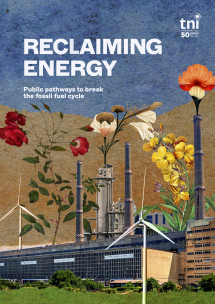
Downloads
-
Reclaiming Energy: Public pathways to break the fossil fuel cycle (PDF, 4.64 MB)Average time to read: 180 minutes
-
Executive Summary - Reclaiming Energy: Public pathways to break the fossil fuel cycle (PDF, 1.35 MB)Average time to read: 10 minutes
-
Reclaiming Energy Report: Part 1 - The Profit Trap (PDF, 9.71 MB)Average time to read: 40 minutes
-
Reclaiming Energy Report: Part 2 - Better Public Ownership (PDF, 10.06 MB)Average time to read: 40 minutes
-
Reclaiming Energy Report: Part 3 - Beyond the State (PDF, 6.33 MB)Average time to read: 40 minutes
-
Reclaiming Energy Report: Part 4 - Global Public Goods (PDF, 5.69 MB)Average time to read: 40 minutes
About reclaiming energy
- Publication type
- Report
- Part of series
- Public Power trilogy
Authors
Executive summary
Dominant policy frameworks place market-based approaches at the centre of the energy transition. The narrative is that competition between profit-driven private actors will drive innovation, leading to a smooth transition from fossil to renewable energy and reducing energy bills in the process.
The reality could not be further from this. Decades of market-driven energy policy have been a catastrophic failure. Fossil fuel consumption continues to rise, pushing the world to the brink of climate breakdown.1 Energy bills are increasing, with millions facing energy poverty and lacking access to reliable electricity.2 Inequalities within the energy system are stark, with wealthy countries and companies perpetuating neo-colonial dynamics premised on the exploitation of people, land and resources from across the global South.3 Meanwhile, power resides in the hands of an oligopoly of giant energy firms, which are raking in spectacular profits, without any meaningful democratic accountability or oversight.
Business as usual offers no way out of the fossil fuel trap. The energy industry is wedded to continued fossil fuel use, which suits their business models and bottom line far better than generating energy from the sun, wind and waves.4 Only pathways that centre public ownership allow for the democratic control and popular participation that can break this destructive cycle.
TNI’s Reclaiming Energy report draws on pioneering case studies of community and worker struggle alongside government leadership to offer a vision of what these public pathways might look like. It aims to provide inspiration and practical guidance for a transformed energy system run in the interests of people and planet, rather than profit.
Part of the Public Power files
The Public Power files
- Energy Democracy
- Just Transition
- Lavinia Steinfort
- Rowan Mataram
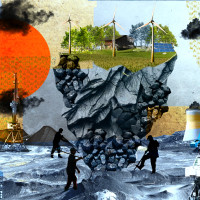
The profit trap
In the words of U.N. Secretary-General António Guterres, ‘present trends are racing our planet down a dead-end 3ºC temperature rise’.5 While global renewable energy investment is rising, renewable capacity increases are far outstripped by rising global energy demand. We are witnessing an energy expansion, rather than an energy transition.6 This is because of the corrosive influence of the profit motive within the energy system, which incentivises ever-escalating growth, extraction and consumption. The fruits of this system are distributed on a highly uneven basis: currently two billion people globally live in energy poverty, with close to 600 million people on the African continent having no electricity access whatsoever.7
Privatisation and marketisation policies were supposed to boost efficiency across the energy system. Yet a researcher at the University of Cambridge who assessed electricity network losses in more than 90 countries worldwide between 1982 and 2008, concludes that the opposite has materialised: with the introduction of private actors in the form of independent power producers, network losses increased.8 Meanwhile, workers’ rights within the energy sector have been eroded and consumer bills have risen.9
Nine out of the top ten countries leading the transition to renewables have a publicly owned renewable energy company that drives the process.10 What’s more, prices are an estimated 20–30 per cent lower in systems with public ownership.11 Yet privatisation and marketisation policies are undermining and dismantling public utilities. Free market policies enforced by international financial institutions have forced governments to ‘unbundle’ the energy sector by creating separate generation, distribution and retail entities -- an obstacle to integrated planning and coordination. Further, with public firms forced to adopt ‘full cost recovery policies’ that require all operational costs to be covered, across the global South, these firms are becoming financially unviable as they are largely supplying people who do not have the ability to pay.12,13
Even where new public energy pathways are introduced, their scope and ambition are often limited by private sector thinking. For example, while the recently elected Labour government in the UK has pledged to establish a new publicly owned energy company, the mission of this company is currently little more than an investment mechanism. Instead of Great British Energy building and owning new renewable generating assets itself, it seems likely it will merely channel public funds into new private renewable projects. Without a public service ethos being at the core of this initiative, it is possible that this new public company will have little significant impact on reducing tariffs or driving decarbonisation.14
This attack on public utilities has paved the way towards an energy sector dominated by a handful of hugely wealthy and hugely powerful private companies. These companies extract huge profits, while being largely reliant on public subsidies to do so. The IMF reported that in 2022, fossil fuel subsidies surged to a record $7 trillion globally.15 Contrary to the arguments made by market proponents, subsidies have undermined competition and concentrated power. Between 2015 and 2020, over 500 oil and gas companies filed for bankruptcy in North America.16 Mergers and acquisitions within the energy market are booming, reaching a record high of $2.9 trillion in transactions in 2021.17
The central issue making profit-driven approaches unworkable is that energy is a natural monopoly. All energy firms rely on the same network of physical infrastructure. Upfront costs are high and competition is challenging. Artificially forcing competition within this context undermines prospects for coordination and planning, in turn making decarbonisation policies extremely difficult to implement.
In sum, the market-based model is sidelining social and environment goals in order to maximise private profits. Consider, for example, the case of Tunisia. Between 1962 and 2016, Tunisia’s public utility firm STEG (Société tunisienne de l'électricité et du gaz) increased electrification from 21% to 99.8 per cent.18 Yet the need to transition to renewables has been used to justify the opening up of Tunisia’s energy system to foreign private companies. The result has been a range of colonial ‘green grabbing’ renewables projects that benefit wealthy northern actors, rather than the Tunisian people, with communities forced from their land without compensation. Meanwhile, STEG has been subject to creeping privatisation and the withdrawal of public subsidies, which has pushed it to financial ruin.19
A similar story can be told about South Africa. Here, state-owned utility Eskom, once a leader in the supply of affordable energy, particularly to the country’s white minority, has been undermined by decades of commercialisation.20 Operating at only 55 per cent of its 46,000 MW production capacity, Eskom’s supply is notoriously unreliable and has frequently had to revert to rolling blackouts.21 These have disproportionately affected poor and Black communities.22 Meanwhile, the utility’s dependence on coal and limited investments in renewables have halted South Africa’s energy transition for decades.23 Eskom is now being unbundled to allow for greater private sector involvement in energy generation, and to expand the liberalisation of the energy sector.24
In both Tunisia and South Africa, communities and workers are fighting back to challenge privatisation and build democratic alternatives. Across both contexts, trade union coalitions have put together inspiring visions of ambitious energy transition informed by social justice and popular control.25 What, then, might public pathways to move beyond the fossil fuel cycle consist of?
Part 1
Reclaiming Energy Report: Part 1 - The Profit Trap Subsidies, Fossil Fuels and Energy Expansion
- Energy Democracy
- Democratic Public Services
- Lavinia Steinfort
- Rowan Mataram
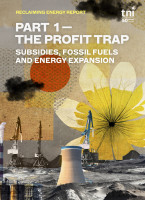
Public pathways
As a first step, radical action is needed to rein in the power of the fossil fuel industry. In 2022, ExxonMobil, Shell, Chevron, BP, and TotalEnergies – the five leading Western oil ‘supermajors’ – reported a combined total of $200 billion in profits, an eye watering $23 million for every hour of 2022.26 These firms are doing all they can to maintain their wealth and power, including vociferous lobbying of politicians and decision-makers. For example, one and a half years into Russia’s invasion of Ukraine, the fossil fuel industry had met with the European Commission more than 100 times.27 In the US, private fossil fuel companies have bought legislators to vote against environmental policies and delay climate action.28 Indeed, between 2022 and 2023, the fossil fuel industry spent at least $213 million on lobbying US politicians.29 Consequently, fossil fuel firms have been able to capture regulation and tax systems to ensure that these mechanisms do not get in their way. Only by nationalising these firms can governments finally reclaim control and begin to plan a meaningful fossil fuel phase-out.
However, nationalisation is no panacea. Many of the most polluting (and wealthy) energy companies in the world are state-owned. The combined profits of the five leading private supermajors – ExxonMobil, Shell, Chevron, BP and TotalEnergies – stood in stark contrast to those of Saudi Aramco, Saudi Arabia’s national oil company. In 2022 alone, Aramco earned just over $161 billion.30 Aramco, alongside other state-owned oil companies from oil-producing states, is standing in the way of climate action. Oil production is growing in many of these contexts.31 Nationalisation and public ownership, while essential, are in themselves no guarantee of just or sustainable energy policies.
What is needed, then, is better public ownership – a model of public ownership that is truly public in design and implementation. A number of pathways can be explored, as set out below:
A new public mandate and mission
Firstly, public utilities can be guided by a new public mandate and mission that set out clear and legally binding social and environmental objectives to govern the firm’s activities. Vietnam’s public utility, for instance, was employed with the explicit goal of expanding the electricity grid, through which it achieved 96 per cent coverage – that is, before 2005 policy reforms in favour of competition or private ownership.32 In the United States, the Southwest Power Pool (SPP), a non-profit regional transmission organisation, is mandated to ensure customers receive reliable power, adequate transmission infrastructure and competitively priced electricity. Its mission: ‘to responsibly and economically keep the lights on, today and in the future’.33 In 2022, SPP was the first regional organisation to meet over 90 per cent of energy demand with renewables.34
Progressive tariffs
Moreover, public utilities can implement progressive tariff structures. Dominant market policies see high-usage and wealthy consumers spending proportionally less on energy than low-income users. A recent UK survey suggests that those who use small amounts of energy are paying up to 30 per cent more for their energy than high-consumption customers.35 Public utilities can rectify this injustice with pricing structures that disincentivise excessive energy consumption and that subsidise the essentials.
In 2022, the government of Honduras passed a landmark law to guarantee electricity as a public good and a human right.36 It guarantees free electricity for the lowest-income households, which should benefit the 900,000 poorest families in the country.37 Cases like this show the potential for a fundamental rethinking of the way that energy is priced and distributed. Utilities could implement participatory processes to co-produce new tariff structures that set out what constitutes ‘essential’ energy use. Low-income households, or perhaps even all residents, could receive an energy budget to ensure that their basic needs are met. Then, beyond essential use, tariffs could increase in proportion to wealth, asset ownership and income – as well as being indexed to whether energy use contributes to personal and social wellbeing.
Re-municipalisation
Another avenue for remaking public ownership comes through re-municipalisation, which sees municipal authorities across towns and cities reclaiming ownership and control of local energy systems. There have been over 1,700 cases of (re)municipalisation in 75 countries around the world, with 381 recorded cases of reclaimed and new energy services or infrastructure, documented in the Public Futures database.38 These initiatives provide opportunities for novel forms of citizen engagement and collaboration within public energy governance.
For example, in 2006, in Wolfhagen, Germany, the municipality took back control of its grid and established a municipal energy company. A citizens’ energy cooperative is represented on the board of the city’s municipal energy company, offering a route for residents to input into the company’s decision-making. This has proved particularly important in decisions over the distribution of the company’s profits, which have been used to lower tariffs, increase staff numbers and fund local childcare, bike schemes and energy system improvements.39
Or take the 2002 energy deprivatisation of Kauai island, Hawaii, when a member-owned energy cooperative took over the for-profit electricity utility.40 This non-profit cooperative is managed by an elected board. They aim to be 100 per cent renewable by 2033 and, as of 2022, were already at 60.2 per cent renewable energy.41
Public-community collaborations
There is a move towards public-community collaborations, which see public institutions co-producing energy policy with citizens’ groups such as co-operatives and other non-profit institutions. Public-community collaborations break down the discrepancy between top-down public ownership on the one hand and decentralised cooperative ownership on the other – maintaining the possibility of large-scale planning and coordination while simultaneously allowing for participatory decision-making and localised control.
The Costa Rican energy system offers a glimpse of what this might look like. Costa Rica has a publicly governed electricity system, featuring a unique combination of a state-owned utility, a regional enterprise, two municipal enterprises and four rural electricity cooperatives. These diverse actors work together to achieve impressive results: over 99 per cent of power generation in the country derives from renewable sources, with close to 100 per cent of the population enjoying energy access.42
For community renewables to thrive and contribute to a wider transition, we need a large-scale publicly planned and owned system, while state-owned utilities must be responsive to people’s needs and the impacts of their operations on the ground. Public-community collaborations can bring together the advantages of both state ownership and localised community control.
Public-public partnerships
Public-public partnership see public institutions working together to share best practice and achieve joint objectives. These kinds of collaborations have been common across the water sector for years and are now picking up in the energy sector.43 In 2019, in Catalonia, 400 municipalities formed the Association of Municipalities and Entities for Public Energy. The aim: to work together towards renewable public power production and retail, while developing forms of citizen participation.44 Meanwhile, Mexico’s new $1.68 billion public solar plant in Puerto Peñasco – set to be the biggest solar plant in Latin America – has been established as a partnership between state-owned utility CFE and the Sonora state government.45 Public-public collaborations are also taking off in the realm of banking – creating funding avenues outside private finance to mitigate and adapt to climate change.46
Taken together, these diverse strategies offer ways to build forms of public ownership that are developed by and for the people. Ultimately, this is about opening up state institutions to popular participation, in order to ensure that workers and communities are at the forefront of the energy transition. However, given the influence currently exerted by the energy industry over governments around the world, it would be naïve to expect these kinds of public pathways to be opened up through the benevolence or democratic intentions of governments themselves. Rather, winning these public pathways will require social movements and trade unions to fight for changing the composition and orientation of state institutions and to shift the balance of power within society more broadly.
Part 2
Reclaiming Energy Report: Part 2 - Better Public Ownership Accountability, Affordability and Democracy
- Energy Democracy
- Democratic Public Services
- Lavinia Steinfort
- Rowan Mataram
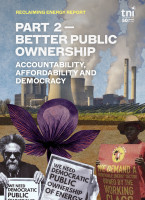
Decolonising the energy system
To break out of the fossil fuel cycle, we must look beyond the state to consider the pivotal role of civil society and grassroots movements in building just and democratic energy transitions. Struggles waged by Indigenous and colonised people to work towards the decolonisation of the energy system are particularly important. Centuries of colonial capitalism have baked deep-rooted inequalities into all aspects of the energy system, from the destructive impacts of energy extraction, generation and transmission through to the uneven ways that energy services are distributed, orientated and accessed.
Indeed, the history of fossil fuel extraction is inseparable from histories of colonial violence. As historian Andreas Malm has argued, the case of Palestine is illustrative here. Israel’s settler colonial expansion has been supported by the US and European states, in large part because of these states’ desire to ensure access to the Middle East’s oil and gas reserves. In turn, resistance to Israel’s control over fossil fuels constitutes a key strategy in the fight for a free Palestine. Calls for an international energy embargo on Israel are gaining traction in light of Israel’s ongoing genocidal violence, with Colombia halting coal exports to Israel in 2024.47
The energy transition is now reproducing colonial dynamics which see the people, land and resources of southern countries extracted and exploited for the benefit of wealthy northern elites.48 It has brought new exploitative and polluting mining across many countries of the global South, in pursuit of the minerals and metals needed to build clean energy technologies such as solar panels, wind turbines and batteries. These technologies are largely exported to wealthy northern countries, while southern communities are left facing severe environmental degradation and human rights abuses.49 Land struggles are also intensifying, as seen in Morocco where the proposed ‘Desertec’ solar project has been threatening huge land grabs at the expense of local populations.50
Decolonising the energy system is a call to move towards energy systems that ensure global equity in access and benefits, while keeping environmental harm to an absolute minimum. Further, it is about advocating for making essential energy provision the priority – whether this is to keep hospitals, schools, water services and public transport running, or to power the caring, cooking and cleaning work that is still predominantly done by women. It also means decentring the interests of elites and colonising countries and centring the demands, knowledge and solutions advanced by communities that experience racial and class-based marginalisation.
Energy democracy initiatives led by Indigenous people are one important route towards decolonisation. A risk of top-down public and private energy planning is that communities end up sidelined and losing out from infrastructure development. Indigenous communities are linking demands for affordable renewable energy to the preservation of land, resources and ecosystems, alongside participatory governance.
Consider the case of El Cua, Nicaragua, Here, Indigenous communities, having been left out of national electrification plans, designed and delivered their own localised electricity system. This is guided by the principles of interconnection and dependency on ecosystems, with all profits reinvested within the local community.51 Or take the case of the Navajo Nation in North America, who decided to develop a large photovoltaic solar farm on their reservation land following a deliberative democratic process. Around 200 Indigenous workers were employed and given training to build and maintain the solar photovoltaic farm, knowledge they can share with future generations. The success of the initial project led to a second phase, with the farm now supplying around 36,000 homes.52
Decolonising the energy system also means learning from land and agrarian justice movements. Over a ten-year period, in close alliance with working peoples from Myanmar, TNI has developed an analytical lens called the ‘5Rs’: recognition, restitution, redistribution, regeneration and representation. The five principles are highly interdependent: when one of them is discarded, justice is compromised.53 Two concrete measures are essential companions to the 5Rs: guaranteed minimum access to land and a society-wide land ceiling on the maximum amount of land an individual or corporation can own.54 When applied to energy, this could be seen as the minimum and maximum amount of energy that should be available globally, per capita and per corporation. Adopting these principles could enable a far fairer distribution of the resources needed for the energy transition globally.
Part 3
Reclaiming Energy Report: Part 3 - Beyond the State Decolonisation, Just Transition and Energy Democracy
- Energy Democracy
- Democratic Public Services
- Lavinia Steinfort
- Rowan Mataram
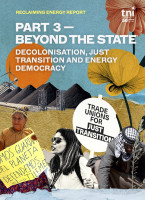
A growing global movement
By bringing together decolonial energy initiatives with trade union struggles for just transition and environmental movements, new and powerful solidarities can be fostered. For instance, Colombia’s decision to halt energy exports to Israel was the result of coordinated campaigning that saw Colombian mineworkers and Indigenous communities affected by the Cerrejon open pit coal mine working together alongside Palestinian liberation organisers.55 This coalition of diverse groups, collaborating across borders, is indicative of a growing global movement for a just, decolonial and democratic energy transition.
Exiting fossil fuels calls for fundamental political and economic change. Nationalisations, re-municipalisation and government leadership have a vital role to play. Yet public energy transitions will not be an expression of popular power unless social movements, trade unions and associations of marginalised people work together to shape transitions and public institutions according to their own needs and interests. Ultimately, to put fossil capital on the backfoot and prioritise social and climate justice, the balance of power in society needs to shift. This means working inside and outside the state to force change and build grassroots solutions that prefigure alternatives.
Across the world, movements are struggling and winning on public pathways that prioritise people and planet over profit. Indeed, there is an abundance of ideas, manifestoes and case studies pointing the way towards a fundamentally transformed energy system across scales. However, the fossil fuel industry is deeply entrenched across cultures, policy-making and economies across the world. Breaking the grip of fossil capital and overturning the profit-based model is the fight of our lifetime.
Part 4
Reclaiming Energy Report: Part 4 - Global Public Goods Public-Public Partnerships and a People's Take-Over
- Energy Democracy
- Democratic Public Services
- Lavinia Steinfort
- Rowan Mataram
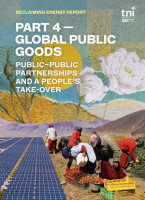
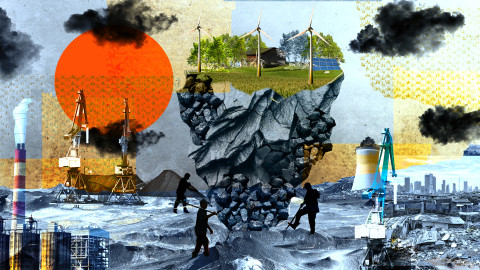
Fourate Chahal El Rekaby
Public Power trilogy
The Reclaiming Energy report concludes TNI's Public Power trilogy, following Energy Transition Mythbusters and 'Green' Multinationals Exposed. This final publication offers systemic solutions to the climate crisis, advocating decolonial, democratic governance and transformative public–community partnerships. Building on the insights of its predecessors, it reimagines energy as a global public good and charts pathways toward just, democratic, and sustainable energy systems.
-
Energy Transition Mythbusters Unpacking the 6 policy myths that threaten decarbonisation
- Energy Democracy
- Just Transition
- Climate Crisis
- Democratic Public Services
Report byPublication date:- Lavinia Steinfort
- James Angel
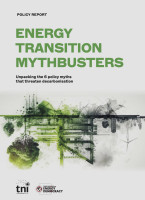
-
'Green' Multinationals Exposed How the energy transition is being hijacked by corporate interests
- Energy Democracy
- Just Transition
- Climate Crisis
- Green Economy
Report byPublication date:- Pratap Chatterjee
- Olivier Petitjean
- Alfons Pérez
- Lavinia Steinfort
- James Angel
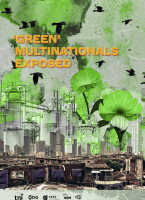
-
Reclaiming Energy Public pathways to break the fossil fuel cycle
- Energy Democracy
- Just Transition
- Democratic Public Services
Report byPublication date:- Lavinia Steinfort
- Rowan Mataram
- James Angel
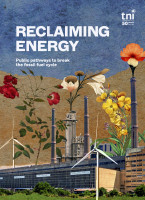
-
The Public Power files
- Energy Democracy
- Just Transition
Dossier byPublication date:- Lavinia Steinfort
- Rowan Mataram

Credits
Editors
REVIEWERS Katie Sandwell, Sylvia Kay, Eleanor Radcliffe and Vera Weghmann
CONTRIBUTORS Louisa Valentin, Pablo Messina and Martín Sanguinetti
DESIGNER Ivan Klisurić / ivanklis.studio
ILLUSTRATOR FACTSHEETS Fourate Chahal El Rekaby
Downloads
-
Reclaiming Energy: Public pathways to break the fossil fuel cycle (PDF, 4.64 MB)Average time to read: 180 minutes
-
Executive Summary - Reclaiming Energy: Public pathways to break the fossil fuel cycle (PDF, 1.35 MB)Average time to read: 10 minutes
-
Reclaiming Energy Report: Part 1 - The Profit Trap (PDF, 9.71 MB)Average time to read: 40 minutes
-
Reclaiming Energy Report: Part 2 - Better Public Ownership (PDF, 10.06 MB)Average time to read: 40 minutes
-
Reclaiming Energy Report: Part 3 - Beyond the State (PDF, 6.33 MB)Average time to read: 40 minutes
-
Reclaiming Energy Report: Part 4 - Global Public Goods (PDF, 5.69 MB)Average time to read: 40 minutes
-
Ritchie, H. and Rosado, P. (2024) ‘Fossil fuels’, Our World in Data. Available at: https://ourworldindata.org/fossil-fuels (Accessed: 13 June 2024).
-
ENPOR (no date) ‘Energy poverty’. Available at: https://enpor.eu/energy-poverty (Accessed: 19 July 2024); & Galal, S. (2024) Population without access to electricity in sub-Saharan Africa from 2000 to 2021’, Statista. Available at: https://www.statista.com/statistics/1221698/population-without-access-t… (Accessed: 19 July 2024).
-
Hickel, J. (2018) The divide: a brief guide to global inequality and its solutions. London: William Heinemann.
-
Steinfort, L. and Angel, J. (2023) Energy Transition Mythbusters. Amsterdam: Transnational Institute
-
Carrington, D. (2023) ‘World facing “hellish” 3C of climate heating, UN warns before Cop28’, The Guardian, 20 November. Available at: https://www.theguardian.com/environment/2023/nov/20/world-facing-hellis… (Accessed: 28 October 2024).
-
Sweeney, S., Treat, J. and Chavez, D. (2021) Energy Transition or Energy Expansion? TNI and TUED. Available at: https://www.tni.org/en/publication/energy-transition-or-energy-expansion (Accessed: 28 October 2024).
-
ENPOR, ‘Energy poverty’); & Galal, S. (2024) Population without access to electricity in sub-Saharan Africa from 2000 to 2021’).
-
Erdogdu, E. (2011) ‘What Happened to Efficiency in Electricity Industries After Reforms?’ Available at: https://mpra.ub.uni-muenchen.de/32483/1/MPRA_paper_32483.pdf (Accessed: 30 October 2024).
-
Steinfort, Angel, Energy Transition Mythbusters.
-
We Own It (2022) ‘Guess which of the top 10 green energy countries DOESN’T use public ownership?’, Available at:
https://weownit.org.uk/blog/guess-which-top-10-green-energy-countries-d… (Accessed: 28 October 2024).
-
Hansard (2022) ‘Public ownership of energy companies’, vol. 721, col. 254WH. Available at: https://hansard.parliament.uk/commons/2022-10-31/debates/D2E93BD7-1A0E-… (Accessed: 29 July 2024).
-
Prior to full cost recovery policies being enforced, public utilities were typically free to prioritise social goals such as increased affordability and access over the need to generate revenues and cover all costs. This was achieved via government subsidies and support to top-up the funds made via consumer bills.
-
Steinfort and Angel, Energy Transition Mythbusters.
-
Green, M. (2024) ‘Labour’s Great British Energy: “Investment vehicle, not an energy company”’, Current News, 31 May. Available at: https://www.current-news.co.uk/labours-great-british-energy-investment-… (Accessed: 26 July 2024); & Hall, D. & Weghmann, V. (2024)’ Will Labour’s Great British Energy company lower household bills?’, The Conversation, 24 June. Available at: http://theconversation.com/will-labours-great-british-energy-company-lo… (Accessed: 28 October 2024).
-
Black, S., Parry, I. and Vernon-Lin, N. (2023) ‘Fossil fuel subsidies surged to record $7 trillion’, IMF, 24 August. Available at: https://www.imf.org/en/Blogs/Articles/2023/08/24/fossil-fuel-subsidies-…. (Accessed: 30 October 2024).
-
Dooley, K. (2021) ‘Over 100 oil and gas companies went bankrupt in 2020’, OGV. Available at: https://www.ogv.energy/news-item/over-100-oil-and-gas-companies-went-ba… (Accessed: 22 July 2024).
-
Sekhon, V. (2022) ‘2022 Emerging trends in U.S. mergers and acquisitions’, Wolters Kluwer. Available at: https://www.wolterskluwer.com/en/expert-insights/2022-trends-in-us-merg… (Accessed: 22 July 2024).
-
STEG (2023) ‘History’. Available at: https://www.steg.com.tn/en/institutionnel/historique.html (Accessed: 29 October 2024) & Ben Rouine, C. and Roche, R. (2022) ‘Renewable’ energy in Tunisia: an unfair transition, TNI, 31 March. Available at: https://longreads.tni.org/renewable-energy-in-tunisia. (Accessed: 30 October 2024).
-
Ben Rouine, C. and Roche, R. (2022) ‘Renewable’ energy in Tunisia: an unfair transition, TNI, 31 March. Available at: https://longreads.tni.org/renewable-energy-in-tunisia. (Accessed: 30 October 2024).
-
Robbins, P. et al. (2024) Who Owns Power in the Energy Transition. TNI. Available at: https://www.tni.org/en/publication/who-owns-power-in-the-energy-transit… (Accessed: 13 September 2024).
-
Mukherjee, P. (2022) ‘Focus: Pandemic, war and “crazy” prices threaten South African pivot from coal’, Reuters, 21 July. Available at: https://www.reuters.com/business/energy/pandemic-war-crazy-prices-menac… (Accessed: 22 July 2024).
-
Mohamood, M. (2023) ‘Energy apartheid: planned power cuts shine a light on electricity inequality’, The Yale Review of International Studies. Available at: https://yris.yira.org/column/energy-apartheid-planned-power-cuts-shine-… (Accessed: 26 November 2024).
-
Mukherjee, P. (2022) ‘Focus: Pandemic, war and “crazy” prices threaten South African pivot from coal’, Reuters, 21 July. Available at: https://www.reuters.com/business/energy/pandemic-war-crazy-prices-menac… (Accessed: 22 July 2024).
-
Kamanzi, B. (2021) ‘The new dawn of private power’, New Frame, 13 July. Formerly available at: https://www.newframe.com/the-new-dawn-of-private-power. [The platform closed down in 2022.]
-
Ashley, et al. (2020), Eskom Transformed: Achieving a just energy transition for South Africa. Amsterdam: Transnational Institute & Ben Ammar (2022) Towards a just energy transition in Tunisia. Amsterdam: Transnational Institute
-
Hanieh, A. (2023) ‘A transition to where? The Gulf Arab states and the new “East–East” axis of world oi’, TNI, 16 November. Available at: https://www.tni.org/en/article/a-transition-to-where-the-gulf-arab-stat… (Accessed: 30 October 2024).
-
Corporate Europe Observatory (2022) ‘Fuelling the cost of living crisis’, 28 October. Available at: https://corporateeurope.org/en/2022/10/fuelling-cost-living-crisis (Accessed: 19 July 2024).
-
Chatterjee et al (2023). ‘Green’ Multinationals Exposed. Amsterdam: Transnational Institute
-
Martinez, C., Kilbury, L. & Martinez, J. (2023) ‘These fossil fuel industry tactics are fueling Democratic backsliding’, Center for American Progress, 5 December. Available at: https://www.americanprogress.org/article/these-fossil-fuel-industry-tac… (Accessed: 22 October 2024).
-
Hanieh, A transition to where?.
-
Hanieh, A transition to where?.
-
Sweeney, S. (2023) Towards a Public Pathway Approach to a Just Energy Transition for the Global South. TUED. p. 26. Available at: https://www.tuedglobal.org/working-papers/second-draft-towards-a-public-pathway-approach-to-a-just-energy-transition-for-the-global-south (Accessed: 29 October 2024).
-
Southwest Power Pool (no date) ‘About us’. Available at: https://www.spp.org/about-us (Accessed: 25 July 2024).
-
MacCrory, J. (2022) ‘Southwest Power Pool first regional organization to serve more than 90 percent of demands with renewable energy’, Innovation Tap LLC. Available at: http://www.innotap.com/2022/04/southwest-power-pool-first-regional-orga… (Accessed: 25 July 2024).
-
Insley, J. (2012) ‘Low users paying more for energy’, The Guardian, 18 September. Available at: https://www.theguardian.com/money/2012/sep/19/low-users-pay-more-energy (Accessed: 29 July 2024).
-
Jae-hun, L., SungHee, O. and Junmo, K. (2023) The Future is Public, Vol. 2. Seoul:Korean Public Service and Transport Workers’ Union (KPTU) & Public Policy Institute for People (PPIP). Available at: https://pop-umbrella.s3.amazonaws.com/uploads/fd4d03b9-bf25-427f-9449-e…. (Accessed: 30 October 2024).
-
Bnamericas (2023) ‘Honduras announces measures to resolve the emergency and sabotage in the energy sector’, BNamericas.com, 23 June. Available at: https://www.bnamericas.com/en/news/honduras-announces-measures-to-resol… (Accessed: 29 July 2024).
-
Transnational Institute and University of Glasgow (2024) ‘Public futures’. Global Database on the de-privatisation and creation of public services. Retrieved from publicfutures.org (Accessed: 13 August 2024).
-
mPower (n.d.) ‘Guide 2: Building energy communities’. Available at: https://municipalpower.org/best-practice-guides/guide2 (Accessed: 16 August 2024); Hopman, L. et al. (2021) Democratic and Collective ownership of Public Goods and Services. TNI. Available at: https://www.tni.org/files/publication-downloads/public_community_collab… (Accessed: 16 July 2024).
-
(Re)municipalisation is understood as the creation of a new public service – municipalisation – or reversals from a period of private management – remunicipalisation. While, municipalities or occassionally higher subnational governments tend to lead this process, this can also be done through community initiatives such as non-profit cooperatives.
-
Public Futures (2024) ‘Case #1181’. Available at: https://publicfutures.org/cases/1181 (Accessed: 13 August 2024). & Kauai Island Utility Cooperative (n.d.) ‘About us’. Available at: https://www.kiuc.coop/about-us (Accessed: 13 August 2024).
-
Messina, P. and Sanguinetti, M. (2023) “Public electricity held accountable by Costa Rica's popular struggle for energy democracy”. Amsterdam: Transnational Institute
-
Hall, D. et al. (2009) Public–Public Partnerships (PUPs) in Water. TNI. Available at: https://www.tni.org/en/publication/public-public-partnerships-pups-in-w… (Accessed: 13 August 2024).
-
Interview with Irene Gonzalez of Engineers Without Borders (ISF Cataluña) on 9 May 2024. For more information about the Association of Municipalities and Entities for Public Energy: AMEP (2024) Home page. Available at: https://amep.cat/ (Accessed: 6 November 2024).
-
Moreno, G. (2022) ‘Gobernador Alfonso Durazo presenta proyecto de planta solar en Puerto Peñasco’, El Sol de Hermosillo, 18 January, https://www.elsoldehermosillo.com.mx/local/gobernador-alfonso-durazo-pr… (Accessed: 13 August 2024). & Ramos, J.L. (2021), ‘CFE's photovoltaic megaplant will be financed mostly with debt’, El Sol de México, 6 November, https://www.elsoldemexico.com.mx/mexico/sociedad/megaplanta-fotovoltaic… (Accessed: 13 August 2024).
-
Marois, T. et al. (2023) Fostering a Global Public Financial Ecosystem for Development and Climate Action. G20 Brasil 2024. Available at: https://www.t20brasil.org/media/documentos/arquivos/TF03_ST_02_Fosterin… (Accessed: 1 November 2024).
-
Malm, A. (2024) The destruction of Palestine is the destruction of the Earth, Verso, 8 April. Available at: https://www.versobooks.com/blogs/news/the-destruction-of-palestine-is-t… (Accessed: 13 August 2024).
-
Hickel, The divide.
-
Hickel, The divide.
-
Hamouchene, H. (2021) ‘Green hydrogen: the new scramble for North Africa’, Al Jazeera, 20 November. Available at: https://www.aljazeera.com/opinions/2021/11/20/green-hydrogen-the-new-sc… (Accessed: 13 August 2024).
-
Colbert, M. (2017) ‘El Cua, Nicaragua’, Energy Democracy, 22 December. Available at: https://energy-democracy.net/el-cua-nicaragua/ (Accessed: 30 July 2024).
-
Vandenack, T. (2024) ‘Navajo Nation solar power plant, meant to help with electrification, gets federal financing’, KSL.com, 30 March. Available at: https://www.ksl.com/article/50965108/navajo-nation-solar-power-plant-me… (Accessed: 13 September 2024) & US Department of Transportation (n.d.) ‘Center for Innovative Finance Support – Navajo Nation Kayenta solar program (Phase I & II), Arizona’. Available at: https://www.fhwa.dot.gov/ipd/project_profiles/az_navajo_nation_kayenta_… (Accessed: 13 September 2024).
-
Franco, J. and Borras, J. (2021) The 5Rs in Myanmar. TNI. Available at: https://www.tni.org/en/publication/the-5rs-in-myanmar (Accessed: 13 August 2024).
-
Franco and Borras, The 5Rs in Myanmar.
-
Hearst, K. (2024a) ‘Bogota’s Israel coal exports ban fuelled by Palestinian-Colombian coalition’, Middle East Eye, 11 June. Available at: https://www.middleeasteye.net/news/colombia-israel-coal-export-ban (Accessed: 1 August 2024).
Publication: Newsletter banner
Did you enjoy reading this content?
Sign up for the newsletter to receive monthly updates on TNI’s research, events, and publications.
Newsletter Subscribe to our newsletter
More like this
-
Energy Transition Mythbusters Unpacking the 6 policy myths that threaten decarbonisation
- Energy Democracy
- Just Transition
- Climate Crisis
- Democratic Public Services
Report byPublication date:- Lavinia Steinfort
- James Angel

-
'Green' Multinationals Exposed How the energy transition is being hijacked by corporate interests
- Energy Democracy
- Just Transition
- Climate Crisis
- Green Economy
Report byPublication date:- Pratap Chatterjee
- Olivier Petitjean
- Alfons Pérez
- Lavinia Steinfort
- James Angel

-
The Public Power files
- Energy Democracy
- Just Transition
Dossier byPublication date:- Lavinia Steinfort
- Rowan Mataram

-
Our Future is Public Energy Democracy Movements Declaration
- Remunicipalisation
- Democratic Public Services
- Energy Democracy
DeclarationPublication date: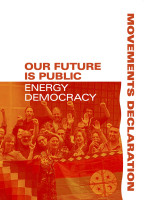
-
Dismantling Green Colonialism Energy and Climate Justice in the Arab Region
- Middle East and North Africa
- Just Transition
- Energy Democracy
Dossier byPublication date:- Hamza Hamouchene
- Katie Sandwell
- Joanna Allan
- Hamza Lakhal
- Mahmoud Lemaadel
- Manal Shqair
- Karen Rignall
- Saker El Nour
- Razaz H. Basheir
- Mohamed Salah Abdelrahman
- Mohamed Gad
- Asmaa Mohammad Amin
- Chafik Ben Rouine
- Flavie Roche
- Jawad Moustakbal
- Adam Hanieh
- Imane Boukhatem
- Christian Henderson


